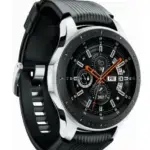
This instruction manual is for Orient mechanical watches, including models AA-F69, AA00-C0, AA00001B, AC-F67, AG-F6T, AP-F62, and EMAM63. The manual provides important information on the usage of mechanical watches and outlines safety precautions to prevent physical danger and property damage. The manual includes detailed instructions on water-resistance, shock-proofing, magnetism, vibration, temperature, and chemical resistance. It also provides guidance on how to identify the caliber number of the watch and the specifications of individual component parts. The manual emphasizes the importance of keeping the crown pushed in at all times and not operating it underwater or while the watch is wet. It also highlights the significance of avoiding strong jets of mains water and rinsing seawater off the case after exposure to avoid corrosion. The manual provides useful information on the luminous light on the hands and dial and how to identify the caliber number of the watch. It is essential to read and understand this instruction manual for prolonged use and optimum performance of the Orient mechanical watches.
MECHANICAL WATCHES
INSTRUCTION MANUAL
Thank you for choosing our product. To ensure prolonged use and optimum performance, please read this instruction manual carefully and familiarize yourself with the terms of the guarantee. Please keep this Instruction Manual handy for future reference.
SAFETY PRECAUTIONS
Make absolutely sure to observe the demarcated contents indicated below to prevent any possible physical danger and property damage to you as well as other people concerned.
![]() WARNING: A demarcation with this symbol represents the contents assuming the possibility for death or serious injury when the product is used in any manner different from given instructions.
WARNING: A demarcation with this symbol represents the contents assuming the possibility for death or serious injury when the product is used in any manner different from given instructions.
![]() CAUTION A demarcation with this symbol represents the contents assuming the possibility of causing human injury or material damage only when a product is used in any manner different from given instructions.
CAUTION A demarcation with this symbol represents the contents assuming the possibility of causing human injury or material damage only when a product is used in any manner different from given instructions.
IN HANDLING THE WATCH
Water-resistance
| Conditions
of use/Type |
Underwater
operation of crown and operation of crown with drops of water on it |
Exposure to small amounts of water(face-washing, rain, etc.) | Water sports
(swimming, etc.), frequent contact with water (car-washing, etc.) |
Skin diving
(air tanks are not used) |
Scuba
diving (air tanks are used) |
Mixed-gas
Diving (using helium gas) |
||
| Nonwater resistant | Without WATER RESISTANT(WATER
RESIST) |
× | × | × | × | × | × | |
| Water
resistant watches |
Water
resistant for daily life |
WATER-RESISTANT(WATER
RESIST) |
× | Ο | × | × | × | × |
| Reinforced
water resistance for daily life I |
WATER-RESISTANT(WATER RESIST)
50m (5bar) |
× | Ο | Ο | × | × | × | |
| Reinforced
water resistance for daily life II |
WATER-RESISTANT (WATER
RESIST) 100m (10bar) 200m (20bar) |
× | Ο | Ο | Ο | × | × | |
| Diver’s
watches |
Diver’s
watch for Air Diving |
AIR DIVER’S 100m / 150m 200m | × | Ο | Ο | Ο | Ο | × |
| Diver’s
watch for Mixed-gas Diving |
He-GAS DIVER’S 200m / 300m /… | × | Ο | Ο | Ο | Ο | Ο | |
![]() WARNING
WARNING
- A watch with water resistance for daily life 30M (3 bar) can be used during face-washing, etc. but cannot be used in an environment in which it will be submerged in water.
- A watch with reinforced water resistance for daily life I 50M (5 bar) can be used while swimming, etc. but cannot be used during any type of diving including skin diving.
- A watch with reinforced water resistance for daily life II 100M or 200M (10 or 20 bar) can be used while skin diving, but cannot be used while scuba diving using oxygen tanks or saturation diving using helium gas, etc.
![]() CAUTION
CAUTION
- Keep the crown pushed in at all times (in the normal position) while using the watch. If the crown is the screwed-down type, check that it is securely screwed down.
- Do not operate the crown underwater, or while the watch is wet. Water may enter the interior of the watch and defeat the water resistance. If your watch is non-water resistant, beware of splashes of water (during face washing, rain, etc.) and sweat. If the watch becomes wet from water or sweat, wipe the moisture off with a dry, soft cloth.
- Even with a water-resistant watch for everyday use, avoid directing strong jets of mains water onto the watch. Water pressure above the limit can apply, which may defeat the water resistance.
- With a water-resistant watch for everyday use, rinse seawater off the case after exposure, then wipe it thoroughly to avoid corrosion and other effects.
- The interior of the watch contains some amount of moisture, which may cause fogging on the inside of the glass when the outside air is cooler than the internal temperature of the watch. If the fogging is temporary it causes no harm inside the watch, but if prolonged, or if water enters the watch, consult your place of purchase and do not leave the problem
untreated.
Shock
- Be sure not to carry the watch when you engage in strenuous sports, whereas playing such light sports as golf, etc., will not adversely influence the watch.
- Avoid a violent shock such as dropping the watch on the floor.
Magnetism
- If the watch is left at a location with strong magnetism for an extended period of time, the components may be magnetized, resulting in malfunction. Be careful.
- The watch may temporarily speed up or slow down when exposed to magnetism. Precision is restored when placed away from magnetism. In such a case, reset the time.
Vibration
The watch may lose precision if subjected to strong vibrations such as from riding motorcycles, using jackhammers, chain saws, etc.
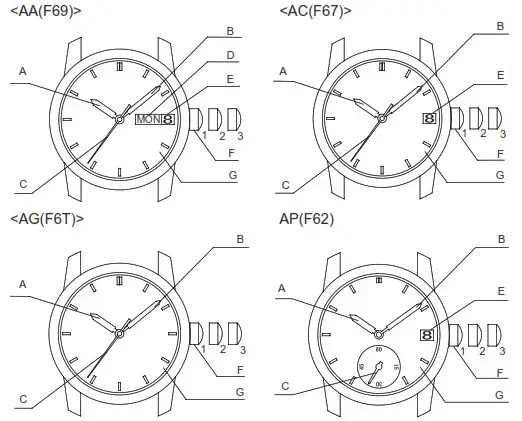
Temperature
In environments below and above normal temperatures (5°C-35°C), the watch may malfunction and stop.
![]() CAUTION
CAUTION
Do not use the watch at high temperatures, such as in a sauna. The watch may heat and cause burns.
Chemicals, Gases, etc.
Utmost caution must be exercised when coming into contact with gases, mercury, chemicals (paint thinner, gasoline, various solvents, detergents containing such components, adhesives, paint, drugs, perfumes, cosmetics, etc.), and so forth. Such may cause discoloration of the watchcase, watchband, and dial face. Discoloration, deformation, and
damage to various resin-based component parts may also occur.
About accessory parts
![]() CAUTION
CAUTION
Do not attempt to disassemble or modify the watch.
![]() WARNING
WARNING
Store the bracelet/strap pin and other small parts out of the reach of children.
If any small parts are swallowed, immediately contact a doctor.
Allergic reactions
![]() CAUTION
CAUTION
If you develop a skin rash or your skin becomes abnormally irritated due to contact with the watch or strap, stop wearing the watch immediately and consult a doctor.
About “luminous light”
This watch has luminous light on the hands and dial. The luminous light is a safe paint that stores sunlight and artificial light without using any radioactive material and emits that light in a dark setting. As the paint discharges the stored light, it will become dimmer over time. The amount of light emitted and the time that light is emitted
depends on various factors when the light is stored, such as the shape of the glass, the thickness of the paint, surrounding brightness level, the distance from the watch to the light source, and the light absorption level. Please note that when not enough light energy is stored, the watch may emit weak light or emit light for only a short time.
Water-resistant watchband
Some products employ leather and nylon bands on which a special treatment to resist perspiration and water absorption has been applied. Please understand that the water-resisting effect of this watchband can be lost depending on the period and conditions of use.
HOW TO IDENTIFY THE CALIBER NUMBER
Check the caliber number by referring to the model number of your watch or the case code on the watch’s case back.
Searching by 10-digit model number
Check the 10-digit model number on the guarantee supplied with your watch. You can also see the number on the product tag put on the watch. Its second and third digits indicate the caliber number of your watch.
Example: If the model number is “AA00001B”, the caliber number is “AA”.
Searching by the case code
See the case code on the case back of your watch. The first two digits indicate the caliber number.
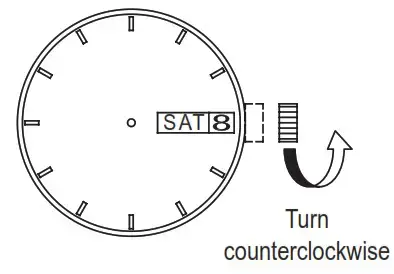
Example: When the case code is “AA00-C0”, the caliber number is “AA”.
- The place of the case code may vary and its letter size may be small and difficult to see depending on the characteristics of watches.
- The pictures and illustrations on this manual may differ from the actual appearance of your watch but the function and operation procedures are the same.
SPECIFICATIONS
| Caliber | Number of jewels |
Date | Day of week | Second-hand halt mechanism |
Remarks* | |
| AA | F69 | 22 | o | o | o | 8:00P.M.-4:00A.M. |
| AC | F67 | 22 | o | — | o | 8:00P.M.-2:00A.M. |
| AG | F6T | 22 | — | — | 0 | 8:00P.M.-4:00A.M. |
| AP | F62 | 24 | 0 | — | 0 | 8:00P.M.-1:00A.M. |
- Vibrations: 21,600 vibrations/1 hour
- Daily accuracy: +25 sec. to -15 sec.
- Drive system: Mainspring winding (Hand-winding)
- Running time: More than 40 hours
- Shock-proof bearings to protect the balance with hairspring from shocks.
The stated daily accuracy is in the following conditions:
- After 24 hours at room temperature with the mainspring wound fully and the dial facing up.
- Due to the characteristics of the automatic winding watch, the time may deviate from the stated “daily accuracy” depending on the following conditions: the amount of time the watch is worn each day, the position of the watch, movement of your arm, winding condition of the mainspring.
- Determine the deviation from not just a day but a period of about a week. Product specifications may change without notice, for improvement.
![]() CAUTION
CAUTION
- Avoid setting the date during the time periods listed in “Remark1” above since the calendar changes during this time. If the date is set during this time period, the date may not change or the watch may malfunction. Be sure to move the hour and minute hands away from this time period when setting the date.
Chemical Resistance
| AA-F69 | AA00-C0 | AA00001B | AC-F67 | AG-F6T | AP-F62 | EMAM63 |
|---|
| Exercise utmost caution when coming into contact with chemicals, gases, etc. as they may cause discoloration, deformation, and damage to various component parts | Exercise utmost caution when coming into contact with chemicals, gases, etc. as they may cause discoloration, deformation, and damage to various component parts | Exercise utmost caution when coming into contact with chemicals, gases, etc. as they may cause discoloration, deformation, and damage to various component parts | Exercise utmost caution when coming into contact with chemicals, gases, etc. as they may cause discoloration, deformation, and damage to various component parts | Exercise utmost caution when coming into contact with chemicals, gases, etc. as they may cause discoloration, deformation, and damage to various component parts | Exercise utmost caution when coming into contact with chemicals, gases, etc. as they may cause discoloration, deformation, and damage to various component parts | Exercise utmost caution when coming into contact with chemicals, gases, etc. as they may cause discoloration, deformation, and damage to various component parts | Exercise utmost caution when coming into contact with chemicals, gases, etc. as they may cause discoloration, deformation, and damage to various component parts |
NAMES AND FUNCTIONS OF INDIVIDUAL COMPONENT PARTS
A: Hour hand
B: Minute hand
C: Second hand
D: Day of the week
E: Date
F: Crown
G: Dial
1. Normal position
2. First click: Calendar setting
3. Second click: Time setting
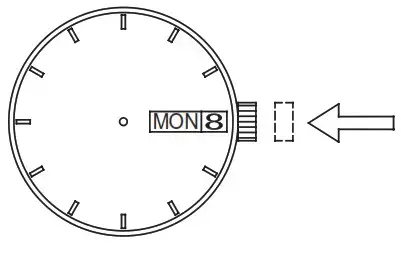
- The position of the crown, date indicator, or day of the week window may be different, depending on the model
AUTOMATIC WINDING MECHANISM
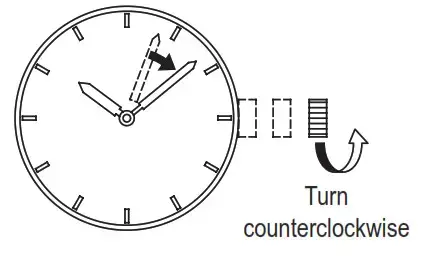
- The mainspring is wound by natural movements of your arm when wearing the watch on your wrist. If your watch stops, swing the watch back and forth ten or more times to re-start the second hand. After it starts moving, set the date and time.
- This watch will run approximately 40 hours after it is fully wound. If it is not wound enough, the watch may lose accuracy. In order to maintain the watch’s accuracy, we recommend wearing the watch for at least 8 hours a day.
HAND-WINDING MECHANISM
- The mainspring is wound up manually.
- To wind the spring, ensure that the crown is in its normal position and slowly turn it clockwise. Turning the crown counterclockwise will have no effect.
- When the watch is in the stopped state, the spring can be wound sufficiently by rotating the crown approximately 30 times. Since the crown will rotate even when the winding is complete, wind the watch using the above number of turns as a guide.
- This watch will run approximately 40 hours after the spring is fully wound.
MODELS WITH SCREWED-DOWN CROWN
Depending on the model, you may not be able to pull the crown out without unscrewing it (models with screwed-down crowns). Operate this type of watch as follows:
- Before setting the date and time, first, turn the crown counterclockwise to loosen the screw lock.
- After setting the date and time, turn the crown clockwise while pressing in, until it stops turning to securely tighten the screw.
HOW TO SET THE TIME and CALENDAR [AA(F69)]
(1) Pull out the crown to the second click when the second-hand reaches the 12 o’clock position. (The second-hand stops.)
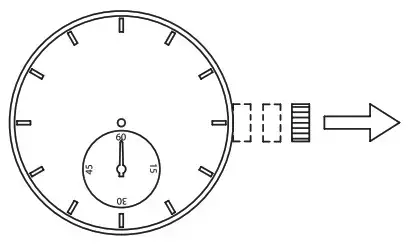
(2) Turn the crown counterclockwise and set the current time.
- When setting the time, first bring the hand back slightly earlier than the actual time and then move it forward to the actual time.
- For the watch with a calendar, make sure that you set either a.m. or p.m. without fail. The date changes at [twelve o’clock midnight].
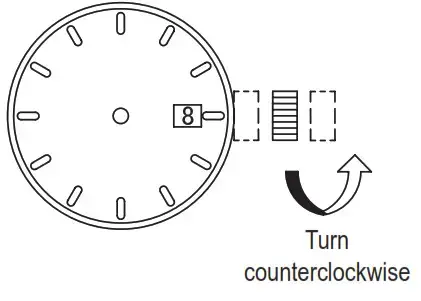
(3) Pull the crown out to the first click.
- The crown on this watch can be pulled out with either of two clicks.
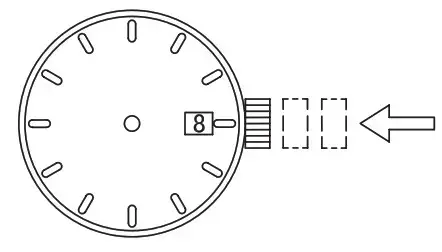
(4) Turn the crown counterclockwise, and set the date to that for the current day.
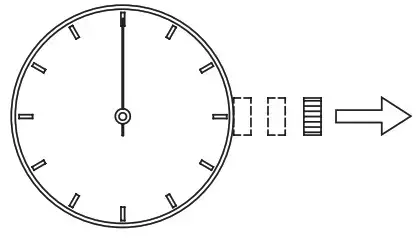
(5) Turn the crown clockwise to set the day of the week to the current day.
- This watch has a bilingual day of the week function. Turn the crown to select the desired language. The display languages differ depending on the model.
- Correcting the date at the end of the month The date will have to be corrected for months that have 30 days, or those that have less than 30 days. After the date switches over to the first day of the succeeding month, set the date to the [First (1)].
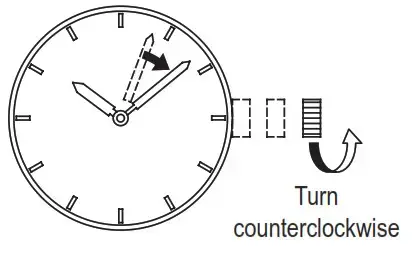
(6) Push the crown back to the normal position.
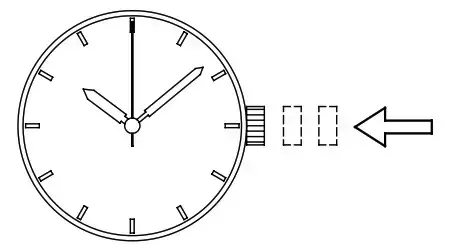
HOW TO SET THE TIME and CALENDAR [AC(F67)]
(1) Pull out the crown to the second click when the second-hand reaches the 12 o’clock position. (The second-hand stops.)

(2) Turn the crown counterclockwise and set the current time.
- When setting the time, first bring the hand back slightly earlier than the actual time and then move it forward to the actual time.
- For the watch with a calendar, make sure that you set either a.m. or p.m. without fail. The date changes at [twelve o’clock midnight].
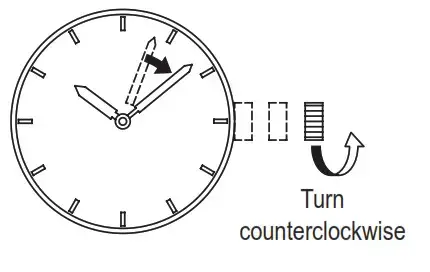
(3) Pull the crown out to the first click.
- The crown on this watch can be pulled out with either of two clicks.

(4) Turn the crown counterclockwise, and set the date to that for the current day.
** Correcting the date at the end of the month
The date will have to be corrected for months that have 30 days, or those that have less than 30 days. After the date switches over to the first day of the succeeding month, set the date to the [First (1)].

(5) Push the crown back to the normal position.
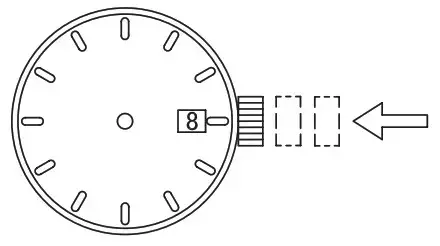
HOW TO SET THE TIME [AG(F6T)]
(1) Pull out the crown to the second click when the second-hand reaches the 12 o’clock position. (The second-hand stops.)
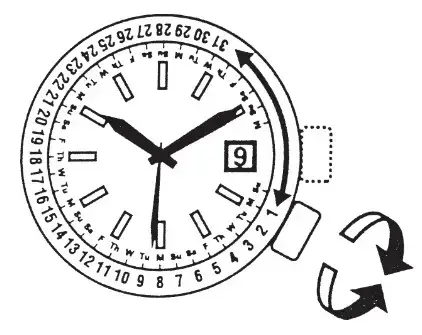
(2) Turn the crown counterclockwise and set the current time.
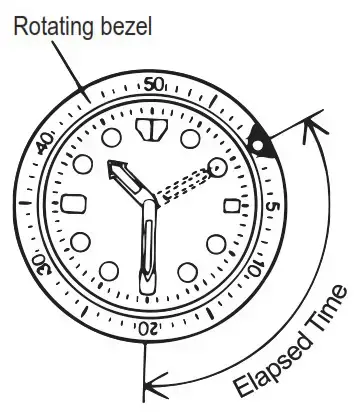
(3) Press the crown into the normal position.
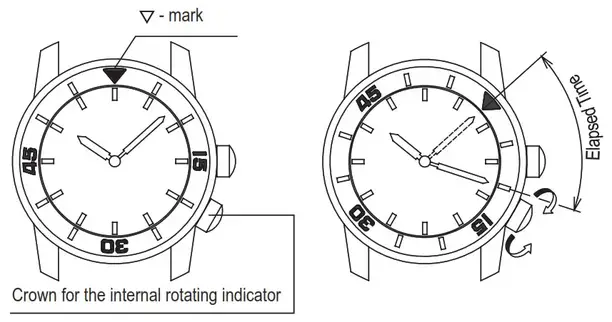
HOW TO SET THE TIME and CALENDAR [AP(F62)]
(1) Pull out the crown to the second click when the second-hand reaches the 12 o’clock position. (The second-hand stops.)

(2) Turn the crown counterclockwise and set the current time.
- When setting the time, first bring the hand back slightly earlier than the actual time and then move it forward to the actual time.
- For the watch with a calendar, make sure that you set either a.m. or p.m. without fail. The date changes at [twelve o’clock midnight].
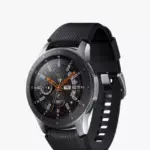
(3) Pull the crown out to the first click.
- The crown on this watch can be pulled out to either of two clicks.

(4) Turn the crown clockwise, and set the date to that for the current day.
- Correcting the date at the end of the month
The date will have to be corrected for months that have 30 days, or those that have less than 30 days. After the date switches over to the first day of the succeeding month, set the date to the [First (1)].

(5) Push the crown back to the normal position.
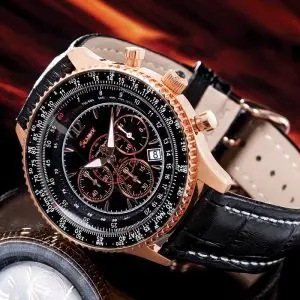
Some models come with a monthly calendar.
The monthly calendar can be used by turning the crown at 4 o’clock position to set the rotating ring inside the watch case and aligning it with the day of the week that is printed on the dial.
Turn the crown to align the first day of the month to the appropriate day of the week.

- Note that when setting the first day of the month, if the days at the end of the month (31st, etc.) are aligned with the section that does not have the days of the week printed on the dial (3 – 4 o’clock side), days of the week will not be indicated at the end of the month.
USING THE ROTATING INDICATOR RING
Please notice that some models come with a rotating indicator ring, which could be used properly.
Turn the ring by pointing the ∇ mark to return the ring by pointing the ∇ mark to the minute hand. While certain time goes by,
you can measure the elapsed time from the distance between minute-hand and figures on the rotating indicator ring. You can also set the ∇ mark as the desired time to remind you how long time is still remain for an appointment.
You cannot turn the ring reversely since it comes with a protection mechanism for preventing the wrong operation by force or shock.
Figures on the ring could also help you to read the current time easily.
- Depending on the design, anti-reversely and 1-minute “click” sound mechanism on rotating indicator ring does not apply to some models.

HOW TO USE THE INTERNAL ROTATING INDICATOR RING
Please notice that some models come with an internal rotating indicator ring, which should be used properly.
Turn the crown for the internal rotating indicator ring to set the ∇ mark to the position of the minute hand.
The position of the internal rotating indicator ring to which the minute hand is pointing after some time has elapsed indicates the elapsed time. Setting the mark to the desired time also allows you to know the remaining time.

FAQS
What should I do if my watch gets wet?
If your watch is non-water resistant, beware of splashes of water (during face washing, rain, etc.) and sweat. If the watch becomes wet from water or sweat, wipe the moisture off with a dry, soft cloth.
Can I operate the crown underwater?
No, do not operate the crown underwater, or while the watch is wet. Water may enter the interior of the watch and defeat the water resistance.
Can I use my water-resistant watch for diving?
It depends on the water resistance level of your watch. A watch with reinforced water resistance for daily life II 100M or 200M (10 or 20 bar) can be used while skin diving, but cannot be used while scuba diving using oxygen tanks or saturation diving using helium gas, etc.
What should I do if my watch is exposed to strong magnetism?
If the watch is left at a location with strong magnetism for an extended period of time, the components may be magnetized, resulting in malfunction. Be careful. The watch may temporarily speed up or slow down when exposed to magnetism. Precision is restored when placed away from magnetism. In such a case, reset the time.
Can I use my watch at high temperatures?
No, do not use the watch at high temperatures, such as in a sauna. The watch may heat and cause burns.
What should I do if my skin becomes irritated from wearing the watch?
If you develop a skin rash or your skin becomes abnormally irritated due to contact with the watch or strap, stop wearing the watch immediately and consult a doctor.
How can I identify the caliber number of my watch?
Check the caliber number by referring to the model number of your watch or the case code on the watch’s case back. See the case code on the case back of your watch. The first two digits indicate the caliber number.
What is the daily accuracy of the Orient mechanical watches?
The stated daily accuracy is +25 sec. to -15 sec. After 24 hours at room temperature with the mainspring wound fully and the dial facing up. Determine the deviation from not just a day but a period of about a week. Product specifications may change without notice, for improvement.
What is the luminous light on the hands and dial?
Luminous light is a safe paint that stores sunlight and artificial light without using any radioactive material and emits that light in a dark setting. As the paint discharges the stored light, it will become dimmer over time. The amount of light emitted and the time that light is emitted depends on various factors when the light is stored, such as the shape of the glass, the thickness of the paint, surrounding brightness level, the distance from the watch to the light source, and the light absorption level. Please note that when not enough light energy is stored, the watch may emit weak light or emit light for only a short time.